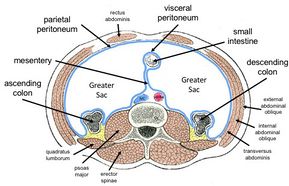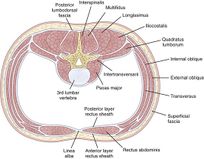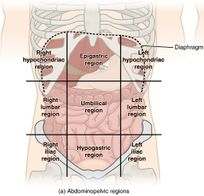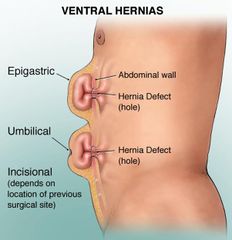Abdominal Muscles
This article or area is currently under construction and may only be partially complete. It will be changed to describe anterior and posterior abdominal walls. Please come back soon to see the finished work! (20/05/2020)
Original Editor - Anne Millar
Top Contributors - Anne Millar, Khloud Shreif, Lucinda hampton, Laura Ritchie, Kim Jackson, Admin, Joao Costa, Scott Buxton, Vidhu Sindwani and Evan Thomas
Introduction[edit | edit source]
The abdomen region is supported by the anterior and posterior abdominal wall that supports the viscera and maintains the posture where there's no bony support.
The anterolateral abdominal wall formed of 4 layer skin, fascia, muscles, and peritoneum. Muscles of the anterior abdominal wall consists of two vertical muscles located on the midline and bisected by linea alba; Rectus abdominis and pyramidalis and three flat muscles on the anterolateral side arranged from superficial to deep; external abdominal oblique, internal abdominal oblique, transversus abdominis.
The posterior abdominal wall consists of lumbar vertebrae, pelvic girdle, muscles, and associated fascia (quadratus lumborum, iliacus, psoas major and minor).
Acting together forming a firm wall that supports the muscles of the spine and helps to maintain an erect posture, Support internal visceral organs where there is no bone, protect the abdominal viscera from injury and help to keep them in their anatomical position. In addition, the contraction of these muscles helps in forceful expiration and to increases the intra-abdominal pressure such as in sneezing, coughing, micturating, defecating, lifting, and childbirth.[1]Have a role in preventing hyperextension.
Anterolateral Abdominal Wall[2][edit | edit source]
Anterior wall fascia[3]
Above the umbilicus it is a single connective tissue sheet as a continuous with superficial fascia. Below the umbilicus divided into two layers, camper’s fascia the superficial fatty layer, and Scarpa's fascia the membranous deep layer. Nerves and superficial vessels run Between the two layers.
Muscles of the anterolateral abdominal wall:
External obliques muscle, the most superficial anterolateral abdominal muscle its fibers run inferomedially, unilateral action results in ipsilateral side flexion and contralateral rotation of the trunk bilateral action to flex the vertebral column by drawing the pubis towards the xiphoid process[4].
Internal obliques directed superiomedially perpendicular to the external obliques it acts unilaterally for ipsilateral trunk rotation and side flexion and bilaterally to compress the abdominal viscera, pushing them up into the diaphragm, resulting in a forced expiration.
Transversus abdominis is the deepest of the abdominal muscles, it is an important core muscle and its primary function is to stabilise the lumbar spine and pelvis before movement of the lower and /or upper limbs occur[5].
Rectus abdominis is a long strap muscle that extends the entire length of the anterior abdominal wall lies close to the midline, it is an important postural and core muscle. With a fixed pelvis, contraction results in flexion of the lumbar spine. When the ribcage is fixed contraction results in a posterior pelvic tilt. It also plays an important role in forced expiration and in increasing intra-abdominal pressure.[4]
Pyramidalis with rectus abdominis it forms the anterior abdominal wall when they contract bilateral tense the linea alba.
Rectus sheet:
The three anterolateral flat muscles (obliques and transversus abdominis) form an aponeurosis on both sides that is a broad flat tendon called rectus sheat, enclose the rectus abdominis, and consists of two layers anterior and posterior layer.
Anterior layer consisting of the aponeurosis of the external obliques and half of internal obliques, the posterior layer formed by the behalf of internal obliques and transversus abdominis. join in midline forming linea alba (in which the abdominal muscles insert) extend from xyphoid process of sternum to symphysis pubis.
At a point midway between the umbilicus and symphysis pubis the posterior wall of the rectus sheet disappears and all aponeurosis sheet presented anterior forming anterior wall.
Peritoneum:
It is a membrane that linin the abdominal cavity, covers all abdominal viscera support the viscera with abdominal muscle and provide, and divided into two layers visceral and parietal Fig1.
Posterior Abdominal Wall[edit | edit source]
Posterior wall muscles:
Quadratus, quadrate shape on the lateral side of the posterior abdominal wall. originate from the ilium directed superior medially to insert into transverse process of L1-L4 and lower border of 12th rib. One of the functions of QL is lateral flexion and extension of the vertebral column and during the inhalation assist with the diaphragm and fixes the 12th rib.
Psoas major, located lateral to the lumbar vertebrae, originate from the transverse process of T12-L5 directed inferolateral and insert into the lesser trochanter. It flexes the thigh at the hip.
Psoas minor, doesn't present in all populations and originates from Tthe 12-L1 transverse process and inserts into pubic pectineal line.
Iliacus, originates from the iliac fossa, and with psoas major they form iliopsoas muscle that is the main flexor of the hip.
Diaphragm, the posterior aspect of the diaphragm.
Posterior wall fascia[7]
It is presented between the muscles and peritoneum and is a continuous sheet with transversalis fascia, it is named according to the area it covers. It attaches to the lumbar vertebrae medially and thoracolumbar fascia laterally and continuous inferiorly with iliac fascia covers the psoas major muscle (psoas fascia).
Thoracolumbar fascia, consists of three layers anterior, middle, and posterior, between which the muscles enclose, quadratus lumborum between anterior and middle, deep back muscles between the middle and posterior layers.
Muscles interpretation[edit | edit source]
From all we mentioned before we can see that all abdominal muscles are linked together even by having a common site of connection or by lying fascia. When contracting one muscle other muscles will contract. For example when you aim to contract TrA at the beginning of contraction you will involve it then if you will continue or contract stronger IO will be involved then EO if you will keep going the rectus abdominis will be involved in the function.
Clinical relevance[edit | edit source]
The abdominal viscera can be palpated through the abdominal wall and their place can be visually marked, the umbilicus is the most marked it is fond usually midway between the xiphoid and symphysis pubis. The linea alba splits the rectus abdominis into two half and extends from a vertical groove that presented from xiphoid process.
The abdomen is divided into 9 regions by two horizontal and two vertical plans, these regions are with benefit to describe the location of pain, identify the visceral organs, and in surgical procedures Fig2.
Transverse abdomimis as a deep abdominal muscle and one of the main important core muscle that contributes to supporting lumbopelvic stability and deficit in its function affects our back causing low back pain (LBP). We need to include it in our rehabilitation program[10]
As we mentioned before the abdominal muscles together participate to maintain your erect posture and prevent hyperlordosis pf vertebral column, hence the abdominal muscles have are flexors at the of the vertebral column. Weakness of lumbar extensors with insufficient abdominal muscle contraction in a way that can not oppose the lordosis participate in developing the hyperlordosis.
Deficit in the abdominal wall muscles congenital from birth or acquired postoperatively as a result of a poor wound healing, wound infection, or acquired weakness after pregnancy and labor for example. can manifest in the form of hernia congenital or acquired.
Congenital hernia happens during infant development as a result of embryological malformations or weakness in the neonatal abdominal wall, it may be fatal in some cases and need urgent and surgical intervention as; gastroschisis, or resolve without need to surgical intervention as in umbilical hernia.
Acquired hernia happens in the area of weakness and varies in its severity[11]:
Umbilical hernia that is more serious and has a higher rate of morbidity in adult more than infants and may need surgical intervention. Inguinal hernia protrudes at the inferior border of anterolateral muscles. Epigastric hernia, above the umbilicus through the midline of the linea alba. Spigelian hernias, and incisional hernia as a result of postoperative incision.
Rectus diastasis happens due to prolong transverse stress on linea alba during pregnancy, or post-menopausal women.
Psoas sign, that indicates there is irritation to the iliopsoas muscle group and you can test it by passive flexion of thigh if there is pain in the lower abdomen the test is positive when it is presented on the right side may be an indication of appendicitis.[12]
physical therapy intervention[edit | edit source]
Abdominal exercises need to be gradually progressed from how to activate muscles and maintain contraction to integrate them with functional movement, but there's special considerations, precaution, and exercise modification that we will take these exercises for a patient with a hernia.
- Abdominal draw in exercise, easy to apply, target mainly transversus abdominis as well as the diaphragm it's an important respiratory exercise[13]. Exercise can be progressed by adding external resistance, upper limb or lower limb movement while holding abdomen drawing in
- Curl up exercise, target rectus abdominis, transverse abdominis, and obliques in addition to hip flexors, chest, and neck, start the exercise with slow movement, few repetitions and make sure the back is in contact with the floor and eccentric curl up is most effective at angle at 30∘.[14]
- Bridging, modified bridging with hip abduction or unstable surface show to increase core stability, trunk control. The activation of internal abdominis, rectus abdominis along with erector spine is greater in modified bridging when compared to standard bridging[16].
- Blank and pilates exercises activate and strengthen core muscles and abdominal muscles
Resources[edit | edit source]
KENHUP, anterior abdominal muscles.
Axial muscles of the abdominal wall and, thorax
TeachMeAnatomy: the anterolateral abdominal wall
Curl up exercise prescription Healthline
For more exercises description
Core stability- physiopedia page
Lumbar motor control training- physiopedia page
References[edit | edit source]
- ↑ Drake RL, Vogyl AW, Mitchell AW. Gray's anatomy for students. 3rd edition. Philadelphia: Churchill Livingstion Elsevier; 2015. 282p.
- ↑ Flament JB. Functional anatomy of the abdominal wall. Der Chirurg; Zeitschrift fur alle Gebiete der operativen Medizen. 2006 May;77(5):401-7.
- ↑ Anterior abdominal wallhttps://teachmeanatomy.info/abdomen/muscles/abdominal-wall/
- ↑ 4.0 4.1 Drake RL, Vogyl AW, Mitchell AW. Gray's anatomy for students. 3rd edition. Philadelphia: Churchill Livingstion Elsevier; 2015. 286p
- ↑ Lee D. The Pelvic Girdle. 2nd Ed. Edinburgh: Churchill Livingstone, 1999.
- ↑ Anatomy Zone. Muscles of the Anterior Abdominal Wall-3D Anatomy Tutorial. Available from: http://www.youtube.com/watch?v=mvOajxO8mXO [last accessed 11/07/15]
- ↑ Posterior abdominal wallhttps://teachmeanatomy.info/abdomen/muscles/posterior-wall/
- ↑ Anatomy Zone. Muscles of the Posterior Abdominal Wall - 3D Anatomy Tutorial. Available from: http://www.youtube.com/watch?v=ovQYBAiv8cI[last accessed 17/5/2020]
- ↑ tendosport. How Abdominal Muscles Work. Available from: http://www.youtube.com/watch?v=4MeLHSjESlU[last accessed 20/5/2020]
- ↑ Selkow NM, Eck MR, Rivas S. Transversus abdominis activation and timing improves following core stability training: a randomized trial. International journal of sports physical therapy. 2017 Dec;12(7):1048.
- ↑ Flynn W, Vickerton P. Anatomy, Abdomen and Pelvis, Abdominal Wall. InStatPearls [Internet] 2019 Dec 9. StatPearls Publishing.
- ↑ https://en.wikipedia.org/wiki/Psoas_sign
- ↑ Oh YJ, Park SH, Lee MM. Comparison of Effects of Abdominal Draw-In Lumbar Stabilization Exercises with and without Respiratory Resistance on Women with Low Back Pain: A Randomized Controlled Trial. Medical Science Monitor: International Medical Journal of Experimental and Clinical Research. 2020;26:e921295-1.
- ↑ Ha SY, Shin DC. The effects of curl-up exercise in terms of posture and muscle contraction direction on muscle activity and thickness of trunk muscles. Journal of Back and Musculoskeletal Rehabilitation. 2020 Feb 28(Preprint):1-7.
- ↑ Health e-University. How to do a Curl Up: Health e-University. Available from: http://www.youtube.com/watch?v=lsWQ0XpiNkE[last accessed 25/4/2020
- ↑ Yoon JO, Kang MH, Kim JS, Oh JS. Effect of modified bridge exercise on trunk muscle activity in healthy adults: a cross sectional study. Brazilian journal of physical therapy. 2018 Mar 1;22(2):161-7.
- ↑ Physio Fitness | Physio REHAB | Tim Keeley. Glute Bridges and back pain - Don't flex the spine! | Feat. Tim Keeley | No.70 Physio REHAB. Available from: http://www.youtube.com/watch?v=SwyDMwpcW38[last accessed 25/4/2020










